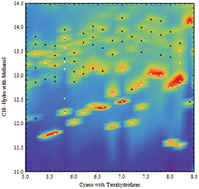Peak picking and the assessment of separation performance in two-dimensional high performance liquid chromatography
Abstract
An algorithm was developed for 2DHPLC that automated the process of peak recognition, measuring their

Maintenance work is planned for Wednesday 1st May 2024 from 9:00am to 11:00am (BST).
During this time, the performance of our website may be affected - searches may run slowly and some pages may be temporarily unavailable. If this happens, please try refreshing your web browser or try waiting two to three minutes before trying again.
We apologise for any inconvenience this might cause and thank you for your patience.
* Corresponding authors
a
Australian Centre for Research on Separation Science (ACROSS), University of Western Sydney node, Parramatta, NSW, Australia
E-mail:
r.shalliker@uws.edu.au
Fax: +61 2 9685 9915
Tel: +61 2 9685 9951
b Nanoscale Organisation and Dynamics Group, University of Western Sydney, Parramatta, NSW, Australia
c Centre for Complementary Medicine Research, University of Western Sydney, Campbelltown, NSW, Australia
d Department of Chemistry, University of Tennessee, Knoxville, TN, USA
e Division of Chemical Sciences, Oak Ridge National Laboratory, Oak Ridge, TN, USA
An algorithm was developed for 2DHPLC that automated the process of peak recognition, measuring their

 Please wait while we load your content...
Something went wrong. Try again?
Please wait while we load your content...
Something went wrong. Try again?
P. G. Stevenson, M. Mnatsakanyan, G. Guiochon and R. A. Shalliker, Analyst, 2010, 135, 1541 DOI: 10.1039/B922759H
To request permission to reproduce material from this article, please go to the Copyright Clearance Center request page.
If you are an author contributing to an RSC publication, you do not need to request permission provided correct acknowledgement is given.
If you are the author of this article, you do not need to request permission to reproduce figures and diagrams provided correct acknowledgement is given. If you want to reproduce the whole article in a third-party publication (excluding your thesis/dissertation for which permission is not required) please go to the Copyright Clearance Center request page.
Read more about how to correctly acknowledge RSC content.
 Fetching data from CrossRef.
Fetching data from CrossRef.
This may take some time to load.
Loading related content
